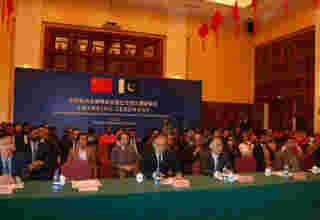Islamabad, September 4 (INP): Tea to trade carries rich potential promoting economic and cultural connections between China and Pakistan, says a report carried by Gwadar Pro on Wednesday.
Tea is deeply woven into the fabric of Chinese culture. According to the Economic Survey of Pakistan 2023-24, in the first nine months of FY 2023-24, Pakistan imported tea worth Rs. 140.861 billion while in FY 2022-23 the import was Rs. 139.454 billion.
With tea imports costing the nation billions each year, there’s a clear need to expand domestic production.
As the second phase of the China-Pakistan Economic Corridor (CPEC) has been focused on agricultural cooperation besides other areas, Pakistan has a valuable opportunity to leverage China’s expertise and technology to cultivate tea on a larger scale.
Pakistan’s tea cultivation has a unique history, beginning long after the tea plant’s journey from China to the Indian subcontinent.
While commercial tea cultivation began in Assam in 1823, Pakistan’s efforts started in the late 1950s, when Rustam Khan Advocate, an agriculturist, pioneered tea growing in the Hazara region of Khyber Pakhtunkhwa.
His successful experimentation led to the establishment of a tea garden, and by the 1980s, over his advice, the government of Pakistan sought Chinese support to further this effort.
This collaboration resulted in the National Tea Research Institute (NTHRI) in Shinkiari, which now produces seven to eight tons of tea annually. However, this is not enough to meet Pakistan’s vast tea needs, as the country remains one of the largest tea importers in the world.
Despite identifying 64,000 hectares of land suitable for tea cultivation, Pakistan currently grows tea on only around 200 acres.
Tea, deeply rooted in the cultures of both nations, symbolizes hospitality and shared traditions, making it a fitting symbol of the growing economic partnership between China and Pakistan.
Through joint ventures and technical support, tea can become a key component of this broader cooperation, promoting self-sufficiency and potential exports in Pakistan.
The report added, from the bustling streets of Beijing to the mountainous regions of Shaanxi and the vibrant landscapes of Xinjiang, tea holds a revered place in the nation’s cuisine.
While China offers an incredible variety of dishes catering to all kinds of food adventurers, one constant remains: the meal always begins and ends with the soothing warmth of green tea.
This tradition, which I observed during my recent visit with a media delegation, highlights tea’s indispensable role in Chinese life. Beyond its culinary uses, tea is also a key element in traditional Chinese medicine and the revered “Chadao” tea ceremony, which has influenced neighboring countries like South Korea and Japan and has shaped cultures worldwide for over a thousand years.
On our first day in Urumqi, the green tea immediately caught my attention. The meal began with a cup of tea, with its aroma rich and inviting. The Uyghur cuisine, featuring dishes like roasted mutton, beef kebabs, and rice, was exceptional. Yet, without the tea, the experience would have felt incomplete.
As a Chinese proverb goes, “Good tea attracts frequent guests,” and it indeed created a bond between hosts and Pakistani guests.
During our visit, we saw peace and harmony reflected in the vibrant faces at the Xinjiang International Grand Bazaar, a lively marketplace rich in the culture of Xinjiang. Amidst traditional music, dance, and singing, one could see people enjoying traditional foods accompanied by green tea and the shops selling it.
Here, green tea completed every culinary experience, underscoring its essential role in daily life and culture.
The Kazanqi Culture Tourism area in Ili is a must-visit for food enthusiasts and those captivated by traditional music and dance.
The area, with its blue-themed streets and historical buildings, offers a visual delight. Our journey through Kazanqi led us to a local family, who warmly welcomed us with a feast of traditional foods.
From the moment we arrived, green tea was a constant companion, refilled throughout the meal, highlighting its cultural importance in the Kazanqi experience.
In Xi’an, the ancient capital of the Tang Dynasty, the Grand Tang Mall is a significant attraction for food enthusiasts and those interested in the rich culture of the dynasty.
Here, green tea plays an essential role, not just as a beverage, but as a cultural symbol connecting the past with the present, reflecting the deep-rooted traditions of Chinese hospitality.
The Tang Dynasty marked the beginning of tea as a popular cultural and social drink. During this period, tea production techniques improved, and the culture of tea drinking spread throughout China.
The famous poet Lu Yu wrote “Cha Jing” (The Classic of Tea) during this era. It is the first book exclusively about tea, detailing its cultivation, preparation, and significance.
Later dynasties, including the Song, Ming, and Qing, further expanded and enhanced tea cultivation.
But who discovered tea? According to legend, Emperor Shennong, a mythical figure from around 2737 BCE, discovered tea when a leaf accidentally fell into his pot of boiling water. The brew, named “Cha,” became the foundation of China’s tea culture.
Tea’s history reflects its deep connection to Chinese philosophy, social customs, and artistic expression.
Whether enjoyed in solitude or shared with friends, tea serves as a bridge to understanding Chinese culture and values.
INP/javed


















